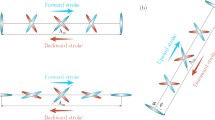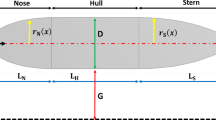Abstract
A test rig is developed to investigate the force and flow field characteristics of tandem flapping wings. The setup comprises a low Reynolds number recirculating water tunnel, two sets of plunge and pitch motion rigs, and a force and flow field acquisition system. A program for the motion and data acquisition is developed based on the NI LabVIEW platform. The water tunnel mainly consists of a water tank, a contraction section, a test section, and a centrifugal pump system. Many kinematic parameters of the tandem flapping motion can be adjusted in our developed test rig. These parameters are the phase angle between flapping motions of the forewing and hindwing, as well as the spacing distance, flapping frequency, and amplitude of the forewing and hindwing. The prominent feature of the motion rigs is that the phase angle can be adjusted continuously from 0 to 360°. The thrust and lift on the flapping wing are measured by a three-dimensional force sensor. A square wave produced by the program is used to identify the start of the flapping motion. The flow field around the flapping wing can be captured by a digital particle image velocimetry (DPIV) at the desired phases of the motion because the DPIV can be triggered by a square wave at any time within a cycle. The boundary of a vortex is determined according to the λ2-criterion with DPIV measurement data, and then its circulation can be computed.














Similar content being viewed by others
References
Streitlien K, Triantafyllou GS, Striantafyllou MS (1996) Efficient foil propulsion through vortex control. AIAA J 34:2315–2319
Jones KD, Platzer MF (1997) Numerical computation of flapping-wing propulsion and power extraction. AIAA Paper 97:826
Fenercioglu I, Cetiner O (2012) Categorization of flow structures around a pitching and plunging airfoil. J Fluids Struct 31:92–102
Tuncer IH, Platzer MF (1996) Thrust generation due to airfoil flapping. AIAA J 34:324–331
Triantafyllou GS, Triantafyllou MS, Grosenbaugh MA (1993) Optimal thrust development in oscillating foils with application to fish propulsion. J Fluids Struct 7:205–224
Hall KC, Hall SR (1996) Minimum induced power requirements for flapping flight. J Fluid Mech 323:285–315
Lian Y, Broering T, Hord K, Prater R (2014) The characterization of tandem and corrugated wings. Prog Aerosp Sci 65:41–69
Lehmann FO (2008) When wings touch wakes: understanding locomotor force control by wake wing interference in insect wings. J Exp Biol 211:224–233
Usherwood JR, Lehmann FO (2008) Phasing of dragonfly wings can improve aerodynamic efficiency by removing swirl. J R Soc Interface 5:1303–1307
Saharon D, Luttges M, (1988) Visualization of unsteady separated flow produced by mechanically driven dragonfly wing kinematics model. AIAA Journal
Warkentin J, Delaurier J (2007) Experimental aerodynamic study of tandem flapping membrane wings. J Aircr 44:1653–1661
Maybury WJ, Lehmann FO (2004) The fluid dynamics of flight control by kinematic phase lag variation between two robotic insect wings. J Exp Biol 207:4707–4726
Yamamoto M, Isogai K (2005) Measurement of unsteady fluid dynamic forces for a mechanical dragonfly model. AIAA J 43:2475
Wang ZJ, Russell D (2007) Effect of forewing and hindwing interactions on aerodynamic forces and power in hovering dragonfly flight. Phys Rev Lett 99:148101
Saharon D, Luttges M, (1989) Dragonfly unsteady aerodynamics: The role of the wing phase relationship in controlling the produced flow, AIAA Journal: 89–832
Broering TM, Lian Y (2012) The effect of phase angle and wing spacing on tandem flapping wings. Acta Mech Sinica 28:1557–1571
Sun M, Lan SL (2004) A computational study of the aerodynamic forces and power requirements of dragonfly (Aeschna juncea) hovering. J Exp Biol 209:1887–1901
Broering T M, Lian Y, Henshaw W (2010) Numerical study of two flapping airfoils in tandem configuration[C]. 48th AIAA aerospace sciences meeting including the new horizons forum and aerospace exposition
Broering TM, Lian Y, Henshaw W (2012) Numerical investigation of energy extraction in a tandem flapping wing configuration. AIAA J 50:2295–2307
Wakeling JM, Ellington CP (1997) Dragonfly flight. II. Velocities, accelerations and kinematics of flapping flight. J Exp Biol 200:557–582
Wang H, Zeng L, Liu H, Yin C (2003) Measuring wing kinematics, flight trajectory and body attitude during forward flight and turning maneuvers in dragonflies. J Exp Biol 206:745–757
Panah A E, Buchholz J (2014) Parameter dependence of vortex interactions on a two-dimensional plunging plate, Experiments in Fluids 55
Baik YS, Bernal LP, Granlund K, Ol MV (2012) Unsteady force generation and vortex dynamics of pitching and plunging aerofoils. J Fluid Mech 709:37–68
Chaoqiang L (1991) Flow field calculation and analysis of rectangle wind tunnel contractions, Acta Aerodynamica Sinica: 379–386
Stratford BS (1958) The prediction of separation of the turbulent boundary layer. J Fluid Mech 5:1–16
Anderson JM, Streitlien K, Barrett DS, Triantafyllou MS (1998) Oscillating foils of high propulsive efficiency. J Fluid Mech 360:41–72
Raffel M (2007) Particle image velocimetry: A practical guide[M]. Springer, 16
Lua KB, Lim TT, Yeo KS (2011) Effect of wing-wake interaction on aerodynamic force generation on a 2D flapping wing. Exp Fluids 51:177–195
Jeong J, Hussain F (1995) On the identification of a vortex. J Fluid Mech 285:69–94
Chong MS, Perry AE, Cantwell BJ (1990) A general classification of three-dimensional flow fields. Phys Fluids A 2:765–777
Hunt JCR, Wray AA, Moin P ((1988)) Eddies, streams, and convergence zones in turbulent flows[C]. Studying Turbulence Using Numerical Simulation Databases, 2
Taylor GK, Nudds RL, Thomas ALR (2003) Flying and swimming animals cruise at a strouhal number tuned for high power efficiency. Nature 425:707–711
Platzer MF, Jones KD, Young JS, Lai JC (2008) Flapping wing aerodynamics: progress and challenges. AIAA J 46:2136–2149
Daniel TL, Combes SA (2002) Flexible wings and fins: bending by inertial or fluid-dynamic forces? Integr Comp Biol 42:1044–1049
Takizawa K, Kostov N, Puntel A, Henicke B, Tezduyar TE (2012) Space–time computational analysis of bio-inspired flapping-wing aerodynamics of a micro aerial vehicle. Comput Mech 50:761–778
Takizawa K, Tezduyar TE, Kostov N (2014) Sequentially-coupled space–time FSI analysis of bio-inspired flapping-wing aerodynamics of an MAV. Comput Mech 54:213–233
Augier B, Yan J, Korobenko A, Czarnowski J, Ketterman G, Bazilevs Y (2015) Experimental and numerical FSI study of compliant hydrofoils. Comput Mech 55:1079–1090
Acknowledgments
Project 50676072 was supported by the National Natural Science Foundation of China and the Fundamental Research Funds for Central Universities.
Author information
Authors and Affiliations
Corresponding author
Rights and permissions
About this article
Cite this article
Jia, B.B., Gong, W.Q. Force and Flow Field Measurement System for Tandem Flapping Wings. Exp Tech 40, 1495–1509 (2016). https://doi.org/10.1007/s40799-016-0136-3
Received:
Accepted:
Published:
Issue Date:
DOI: https://doi.org/10.1007/s40799-016-0136-3




